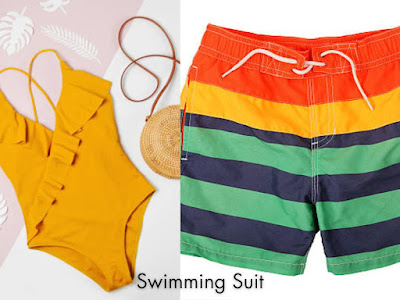Summer Travel Accessories
I never visit a lake, pool, or beach without bringing along my beach bag, reliable sunscreen, sunglasses, sun hat, and water bottle of some kind. The rest is optional yet useful! I've probably worn those flip flops four times in the decades that I've had them. It's how much I adore them. They are easy to clean, comfortable, suitable for boats, waterproof, and float if thrown in the water. Even though I rarely feel sea sick, I always carry Bonine with me. We've gone on dive expeditions where we spent up to a week on small boats at sea, so if there's even a slight possibility you could feel ill, take this instead of the dramamine; you'll thank me for it later. It truly works and doesn't make you drowsy.
 |
| Summer Travel Essentials - Any Time Dress |
The ideal time of year to arrange a trip with your loved ones is during the summer. Summer holidays guarantee an amazing experience, regardless of where you choose to go.
The vacation may help you create lifelong memories that will last a lifetime, from spreading out beach blankets on a soft sand beach to enjoying cool beverages at your poolside bar to swimming with sea turtles along a coral reef to savouring delectable local cuisine and so much more.
When packing for your next summer vacation, whether you're going abroad or just visiting your own country, make sure you have everything you need to travel wisely, securely, and stylishly. Get your summer travel kit ready!
So without further ado, let's examine this packing list champion in more detail.
Swimming suit
A swimsuit is a piece of apparel intended to be worn by participants in water sports like diving, swimming, and surfing as well as activities focused on the sun like sunbathing. Children, women, and men can all wear different sorts. Many terms can be used to refer to a swimming costume; some are specific to certain types of suits or specific places; examples include swimwear, bathing suit, bathing attire, swimming suit, swimmers, swimming togs, bathers, cossie (short for 'costume') or swimming trunks (typically worn by men), among others.
 |
| Swimming suit |
In activities like cold water swimming, water skiing, scuba diving, surfing, and wakeboarding, where a wetsuit or drysuit may occasionally be needed, a swimsuit can be used as an undergarment. As in the case of bodybuilding competitions or beauty pageants, as well as glamour shots and publications like the yearly Sports Illustrated Swimsuit Issue that feature models and sports figures in swimsuits, swimsuits can also be worn to showcase an individual's physical features.
Modern swimwear comes in a huge variety of designs, with differing body coverage and material options. The selection of a style can be influenced by one's own preferences, current trends, and the modesty expectations of the community. The selection process will also take the event into account. For example, it will determine whether the item is to be worn for an active activity like surfing or swimsuit competition, or for a passive occasion like tanning. All swimwear covers at least the wearer's rear end. Nowadays, swimsuits for women typically cover at least the nipples, with the exception of topless bikinis, whereas swimwear for men often exposes the upper body.
Cap / Hat
A hat is a head covering that is worn for a variety of purposes, such as weather protection, fashion accessory, religious, ceremonial, or marking a milestone in life like graduating from college. Hats with mechanical elements, including beer containers, flaps, braces, visors or spikes, fall within the larger heading of headwear.
In the past, hats served as a social status marker. Hats in the military can represent a person's country, rank, regiment, or branch of duty. Police usually wear hats that are easily identifiable, such the Royal Canadian Mounted Police's peaked caps or brimmed hats. Certain hats serve as protective gear. As an illustration, a hard hat shields the head of construction workers from falling objects, a sun hat shields the face and shoulders from the sun, a cowboy hat shields from the rain and sun, and an ushanka fur hat with fold-down earflaps keeps the head and ears warm.
 |
| Cap / Hat |
Certain hats are worn ceremoniously; one such example is the mortarboard, which is carried or worn during university commencement exercises. Certain hats are reserved for people in specific professions; for example, cooks wear toques, and Christian bishops wear mitres. Certain religious adherents wear hats on a daily basis. For example, Sikhs wear turbans, while Christian ladies cover their heads with church hats during prayer and worship.
Hand Purse
A "handbag" is a bigger accessory that may accommodate items other than cash, such personal belongings. Purse and handbag are phrases that are commonly used interchangeably in American English. The early 1900s saw the emergence of the phrase "handbag." In the beginning, it was mostly used to describe men's handbags. During this time, women's purses became bigger and more intricate, and the word was coined to describe the item.
 |
| Hand Purse |
The phrase "pocketbook" refers to a woman's purse that was most often used in the mid-1900s on the East Coast of the United States.
Backpack
In its most basic form, a backpack (also known as a knapsack, rucksack, pack, backpack, bookbag, or backsack) is a cloth sack that is carried on one's back and fastened with two straps that cross the shoulders. However, backpacks can also have internal or external frames, as well as bodypacks.
Since handbags can't hold hefty weights for extended periods of time in the hands, backpacks are the preferable option for carrying heavy loads or any kind of equipment. Backpacks are popular among hikers and students.
 |
| Backpack |



.png)
0 Comments